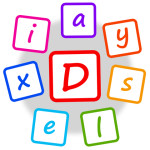 October is Dyslexia Awareness Month.
October is Dyslexia Awareness Month.
Did you know that many children who have dyslexia have not fully integrated their “ATNR” (shorthand for the name of the reflex) and that working on the integration of that reflex can lead to improvements in reading?
The ATNR emerges in utero and helps the baby exit the womb. When an infant turns its head to one side the limbs on that side tend to straighten and those on the other side bend. This linking gives a baby the first sense of hand/eye coordination as well as learning to hear out of both ears and see out of both eyes. Eventually the baby uses this reflex to help develop a sense of midline. Optimally this reflex integrates by about 6 months of age.
A school age child who has not fully integrated this reflex will likely experience difficulties with their eyes working appropriately together creating reading difficulties. Adding the fact that the hands and arms will want to react in response to movements of the head, writing difficulties are also common. There will often times also be issues with physical coordination.
Two luminaries in the field of neurodevelopmental movement say the following:
Harald Bloomberg, M.D. states that ATNR is almost never integrated in children with dyslexia. Svetlana Musgatova, PhD internationally renowned for work with reflexes states that unintegrated ATNR is “one of the most prevalent reasons for failure in school.”
Sounds depressing? The good news here is that ATNR can be integrated at any age with a combination of some hands on and movement work. If your child is experiencing the challenges described above because of a retained ATNR having this corrected can be a game changer.
This Fall I am offering $25 screenings for ATNR as well as other reflexes, balance and proprioception and overall movement quality, particularly as this relates to school success. If your child needs help integrating ATNR or other reflexes I have tools to do that.
Interested? Please call 206-842-4608 or email <moving@drizzle.com>
P.S.
A little back story- I have been interested in movement and learning for a long time. In fact the work I have done for many many years related to pain, injury and neurologic diseases is based on learning to move in new ways. When I started to hear that children who were receiving Anat Baniel sessions for unrelated reasons made academic gains I got really curious. Over the years I have heard of so many kids who struggle in school and parents who have tried so many things to help them. Perhaps there was a way that I could help?
I’ve spent much of the last year exploring what is out there relative to problems with neuromotor development and how it relates to school success with an eye toward integrating some of that along with my Feldenkrais ®/Anat Baniel Method (sm) work.
My bookshelves have become littered with books by Sally Goddard, Kathy Brown, Carla Hannaford and Harald Bloomberg among others. My credit card receipts show the charges associated with trips to San Francisco, Berkeley, Houston, Santa Fe and Vancouver to attend relevant courses and conferences. And then there are a couple of home study courses- one from Kathy Johnson of the Pyramid of Potential and currently an excellent one with Sonia Story of Move, Play, Thrive who herself integrates from a variety of sources. Thank you to these authors as well as teachers I have worked with in person in the last year- Larkhen Carroll, Carol Anne Ericksen, Beverly Stokes, and Diana Razumny and of course to Anat Baniel who planted this seed.
Much of the background information on ATNR and learning in the above blog post can be found elsewhere in a variety of places including those mentioned above. Because Sonia Story along with Steven Kane have produced an excellent manual for their course and I have been reading it most recently, I want to credit them as a source of material regarding the description and effects of the ATNR used in writing this post. “Brain and Sensory Foundations- Neurodevelopmental Movement for Physical, Emotional, Social and Learning Skills. Ó2007-2015.




